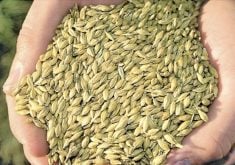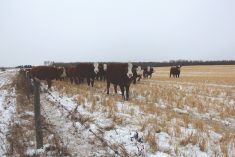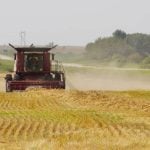When customers visit Mike Buis’ on-farm retail store to purchase beef, they often ask what unusual product he’s feeding his cows that day.
“It keeps it interesting,” says Buis, who farms at Chatham, Ont., and feeds cull vegetables and processing byproducts to his herd. “They need to almost drive directly by the feed bunk to get to the store, so it’s always interesting when they see a great big pile of carrots or a great big pile of ears of corn.”
Buis and his family run around 325 females, finish their own calves and grow several cash crops. When they started their herd shortly after the BSE crisis, cost-effective feed sources were a high priority. “It was really difficult to make a dollar in the cattle business, so we had to find alternative feeds and shortcuts that would work for us,” says Buis.
Read Also

Canadian Beef Check-Off Agency reports on investments and activities
The check-off agency’s work behind the scenes is what ensures cattle check-off dollars are invested wisely, accounted for transparently and deliver measurable value back to producers and importers.
Their location in an area predominantly known for vegetable and cash crop production made this a logical option. “Land values are very high, so pasturing and growing hay is not a viable option for us here,” he says. “So the reason we started using vegetable crops was we could get them virtually for free.”
They source products such as carrots, potatoes, red beets, green and yellow beans and sweet corn. “In the area that we’re in, there’s very little livestock, so as a result there’s no competition for quite a few of these products,” he says. “Most of this comes from the processing industry, so we have a few factories within an hour’s truck ride from our feedlot.”
Feeding livestock cull fruits and vegetables or food processing byproducts is not a new practice by any means, but it’s receiving more attention as producers in some parts of Canada look for alternate feed sources, while others seek options that benefit their cattle and reduce food waste. The availability of different products will depend on region, and supply isn’t always consistent. While there are many benefits to this approach, there are considerations such as cost, storage and nutrition when deciding whether this is the right approach for your operation.
There are legitimate concerns about disease transmission associated with feeding livestock food waste from the consumption phase, or kitchen scraps, and animal by-products. For the purpose of this article, we are discussing plant-based food waste from the processing stage.
Feeding potatoes on P.E.I.
“Cattle will go through anything to get at a potato. They’re highly palatable,” says Halliday, who recommends feeding cull potatoes to feeder cattle 600 lbs. and over. “It’s a good feed for pushing the envelope.”
Similar to any feed, cull potatoes need to be slowly introduced to a ration and in moderation. Chopping potatoes before feeding is recommended to avoid choking hazards, and this can be done with a tub grinder or TMR mixer.
One way to reduce choking risk and prevent spoilage with a large supply is to ensile washed potatoes with fresh-cut silage. The fermentation process will cook the potatoes, says Halliday.
“You can get a four or a five-ounce potato, it’ll actually flatten it like a potato patty, and when you dig those out, they just basically crumble in your hand.”
Feed testing and properly balancing your ration are key. “You’re only dealing with nine per cent protein, so for younger cattle you just make sure you’ve got the protein levels where they should be,” says Halliday. At around 80 per cent total digestible nutrients, potatoes are a good source of energy, and the skins have plenty of vitamins and minerals.
The high moisture content can be a tradeoff, though. “Because they are a wet feed — 80 per cent moisture — the more potatoes you put in the ration, around here because we’re dealing with barns, the more bedding you need,” he says.
In feed trials using potato byproducts, the best performance came from a ration on a dry basis of 40 per cent potatoes, 40 per cent grain, 20 per cent forage and protein and mineral supplementation if needed.
Finding a consistent source of clean cull potatoes is worth careful consideration and spending a little extra money, Halliday says. “Normally we have them available pretty well year-round for some fellows, but lately because we’ve got really good potato storage, a lot of our packing houses don’t start to grade out for the market until probably the middle of January. So sometimes we’ll get a glut of potatoes in January, February, March.”
While Halliday recommends storing potatoes inside to prevent freezing in winter, outside storage is acceptable, as long as frozen potatoes are chopped well enough. In P.E.I., all feed potatoes have to be under cover after June 15 and require a permit for storage.
“That’s more to protect the potato crop this year because if you have cull potatoes that start to sprout, then there’s a blight problem.”
Halliday is seeing more people interested in feeding cull potatoes and byproducts to cattle, as well as other food waste products locally available. “Between brewers’ grains, cabbage, turnips and carrots and potatoes, there seems to be a lot of people out there that want to use them,” he says. “It’s all good fibrous feed, and we can always make use of it.”

Find what works best for you
Because of this, they have to be careful when deciding which products to use in their feedlot, and they’ve found that sweet corn silage, green and yellow beans, brewers’ grains and distillers grains work in this context.
Buis uses a TMR mixer to chop the various products, though they have run into a few choking issues with potatoes and red beets in the past. “If we can, we’ll let potatoes and red beets sit so that they actually start to break down a little and become mushy, and then they’re much easier to feed and much less risky to feed,” he says.
When feeding high-moisture products such as carrots, they add straw to the ration as a buffer to aid in digestion.
Given the high moisture content of some of these products, storage can be a challenge, and items such as carrots need to be fed promptly. “The carrots will lose the juice, so in our bunkers we need to be able to capture that juice,” Buis explains. “The runoff from our feed storage needs to be managed in a special way because obviously we can’t let it get into the streams forever. So we capture that in a liquid lagoon and we spread it as liquid fertilizer on our fields.”
Buis advises producers to carefully weigh the investment, especially when looking at transportation costs and how much you’re getting from each load. “You have to take a serious look at your cost of these products. I’ll use the carrot example: (it’s) 85 to 90 per cent water, so as you’re bringing in a tonne of that, you need to remember that … 10 to 15 per cent of that tonne is actual feed.”
He also advises producers to be vigilant when it comes to sourcing a clean, safe product, and to be aware of the possibility of hardware or plastic in the load. “We’ve actually rejected loads because there’s been plastic and stuff in it.”
Despite some of these challenges, Buis finds the palatability of these products to be very good and his cattle love it. “The cows are not nearly as picky as you’d thought they might be, so bringing in some of these byproducts, they actually will leave good-quality hay or good-quality feed and come running over.”
An angle for consumer connection
“We tested the key messages around grasslands and tested that with a key message of cattle diverting food waste, and asking participants which one resonated with them more. And more people chose the food waste key message,” says Amie Peck, CCA’s public and stakeholder engagement manager.
Audience members expressed their enthusiasm for this practice, stating that knowing this has changed their perception of beef production for the better. “Food waste is something they’re trying to do in their own homes, and so they understand the principles behind it, whereas grasslands seems like kind of an abstract concept if they don’t live close to the grasslands or they don’t understand preserving landscape,” says Peck.
“I’ve heard from a lot of producers some trepidation about linking food waste and cattle, and their concerns are that are people going to think that the food is not high quality, that cattle are being fed garbage,” she continues. “There was not a single comment whether or not this would fit quality standards.”
Peck explains that the industry’s key message on feedlots being the most efficient use of resources in beef production hasn’t resonated with consumers, so they tested this message against a message related to using food waste at feedlots. When asked to choose the message they preferred, 76 per cent of respondents chose the food waste message.
“It gives us a new angle to talk about the role of feedlots and the benefits of feedlots, and really focus on their role in diverting food waste.”
This October, CCA plans to release a short documentary on food waste as cattle feed. “It’s going to be similar to Guardians of the Grasslands in style and tone, and we want to create a suite, so ideally three to five additional videos that all fit together and talk about some of the unexpected benefits of raising beef cattle,” says Peck.
As well, they’re planning an advertising campaign with social media content and strategic partnerships.

















